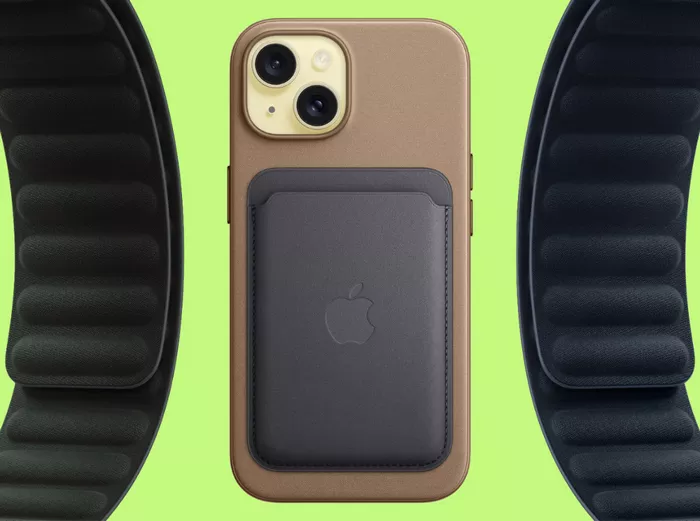During its annual September event, Apple made a groundbreaking announcement that it would discontinue the use of leather across all its product lines, including Apple Watch bands and iPhone cases, as part of its commitment to achieve carbon neutrality by 2030. While Apple has not disclosed the exact composition of its new FineWoven material, it has revealed that this eco-friendly micro-twill fabric contains 68% post-consumer recycled content.
Apple, known for pioneering technology, is setting an example for the industry with this move, which aligns with its pledge to make its entire supply chain and product range carbon-neutral within the next decade. Eliminating leather from its offerings represents a significant stride toward this ambitious goal.
Leather, traditionally derived from animal hides, has long been hailed as a premium material with supposed eco-friendliness due to its biodegradability and durability. However, critics argue that it’s more of a co-product than a byproduct, often playing a primary role in production.
Leather manufacturing is associated with energy- and water-intensive processes, contributing to deforestation, loss of biodiversity, and the release of hazardous chemicals during tanning, posing risks to human health. Additionally, leather has a much higher carbon footprint, emitting 110kg of CO2e per square meter, compared to synthetic and plant-based alternatives, and it is intrinsically linked to animal exploitation.
Embracing a Sustainable Alternative to Leather “Leather is a popular material for accessories, but it has a significant carbon footprint, especially at Apple scale,” stated Lisa Jackson, Apple’s VP of Environment, Policy, and Social Initiatives, during the virtual event. “To reduce our impact, we will no longer use leather in any new Apple products, including watchbands.”
Speculation about this move had been circulating in recent days, particularly after the removal of all Hermès-branded leather bands for the Apple Watch from the website ahead of the event. Apple is replacing leather with FineWoven, a new material touted for its suede-like texture and “significantly lower emissions” compared to leather. Additionally, Apple has collaborated with Hermès, a brand that has previously partnered with a mycelium leather startup, to create four new bands using environmentally friendly materials.
While FineWoven contains 68% post-consumer recycled content, the exact bio-based composition remains undisclosed. Any inclusion of plastic components raises concerns about sustainability, as plastic is notoriously unsustainable, taking an extended period to degrade and contributing to global greenhouse gas emissions. Moreover, plastic-based synthetic leather can shed toxic microplastics, posing threats to aquatic ecosystems and the food chain.
Although Apple’s decision to bid farewell to leather is commendable for the environment and animal welfare, greater transparency regarding the replacement materials would strengthen its climate-conscious image. This announcement comes on the heels of a 7% drop in Apple’s stock price last week, attributed to reports of an iPhone ban for China’s government officials (China accounts for 19% of Apple’s revenue, but less than 1% of its workforce is in the government).
Apple’s Pioneering Steps Toward Carbon Neutrality At the iPhone 15 launch event, Apple also introduced its new Apple Watch lineup, featuring its first-ever carbon-neutral products. This represents another significant stride toward achieving its 2030 climate goal, which centers on reducing carbon emissions by 75% from a 2015 baseline.
Lisa Jackson explained, “For Apple Watch Series 9, we challenged ourselves to significantly reduce greenhouse gas emissions from their three biggest sources: materials, electricity, and transportation. Maximizing recycled and renewable materials in our products is key to Apple 2030 because they have a lower carbon impact than virgin materials.”
Apple’s new watch cases are crafted from 100% recycled aluminum, along with recycled gold, tin, copper, tungsten, cobalt, and more. The company’s watch production facilities now operate entirely on clean energy. To offset the energy used to charge the watches, Apple will invest in global renewable projects to match users’ expected electricity consumption.
In terms of transportation, Apple’s new Apple Watch packaging will consist of entirely fiber-based materials and compact designs, enabling the shipment of 25% more watches per trip. The company also plans to employ low-carbon shipping methods, such as shipping freights, for these products. Apple asserts that these combined efforts have led to a remarkable 78% decrease in its carbon footprint, with the remaining emissions offset by high-quality credits from projects actively removing carbon from the atmosphere.
“At Apple, we have a longstanding and proven commitment to leading the fight against climate change. Our focus on renewable energy and low-carbon design has already driven industry-leading emissions reductions, and we’re not slowing down,” Jackson emphasized. “We’ve achieved an important milestone in making the world’s most popular watch carbon neutral—and we will keep innovating to meet the urgency of the moment.”


